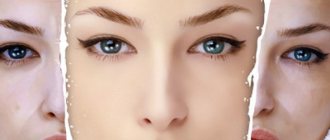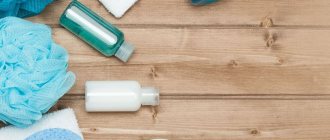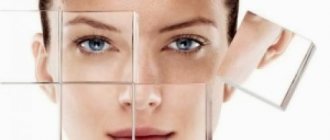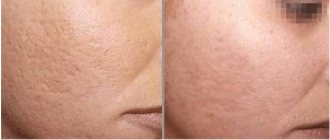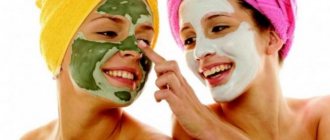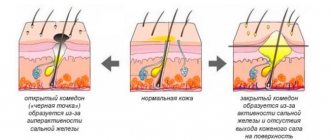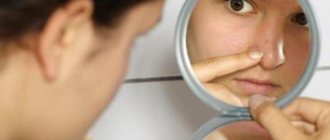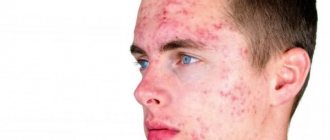Main causes of acne
When the sebaceous ducts and hair follicles become inflamed, dense plugs form. They block the natural regeneration of the skin, provoke inflammation and the appearance of rashes, pimples, and redness. Dermatologists call this epithelial disease “acne.” It is provoked by various factors and causes.
For a long time, doctors believed that rashes on the face, body and head appear when the rules of hygiene and skin cleansing are violated. In fact, acne is a dermatological disease that requires complex treatment with various methods and drugs. Among the main causes of inflammation:
- genetic predisposition;
- increased production of skin secretions;
- period of hormonal formation in adolescents;
- high levels of stress hormone in the blood;
- pathologies of the adrenal glands;
- disruption of the process of regeneration and keratinization of the epidermis;
- improper skin cleansing;
- taking hormonal drugs and anabolic steroids;
- ingestion of chemical compounds with lithium and halogens into the body;
- prolonged contact with chlorine;
- pathologies of the thyroid gland;
- avitaminosis;
- complications during antibiotic treatment and decreased immunity;
- bad habits;
- subcutaneous mite
In women, acne can be caused by the use of low-quality cosmetics with ingredients that close the pores. They cause increased sebum production. The secretion mixes with particles of the epidermis, causing inflammation and rash.
With dysbacteriosis and other intestinal diseases, acne appears due to intoxication. Constipation leads to the accumulation of feces, some of the toxins enter the bloodstream and disperse throughout the body. The rashes concentrate on the cheeks and chin, on the back, the sebaceous shine increases, and the condition of the skin worsens.
Using toothpaste for acne
Toothpaste for acne can act as an ambulance when you need to quickly dry out unpleasant rashes and speed up their healing. The paste received such an unusual use thanks to the antiseptic and anti-inflammatory drugs included in its composition. Toothpaste helps most effectively with local rashes caused by external local infection. If the appearance of acne is associated with deep internal ailments, then, first of all, it is necessary to treat the cause of its occurrence.
Not every paste can be used to combat skin rashes. It all depends on the components included in its composition. In addition, you need to remember that the use of this product can cause irritation, so you should choose it responsibly and know how to use it correctly.
Only a classic white paste, which contains natural ingredients of plant origin: medicinal herbs, oak bark, helps to effectively fight acne. In addition, the white product contains ingredients that help dry out acne: triclosan, baking soda and hydrogen peroxide.
Multi-colored products may contain components that cause irritation, so they are not suitable for medicinal purposes. Products that have a whitening effect should be avoided. They contain components that will not only whiten the skin, but can also leave a burn. People with dark skin types should be especially careful as large amounts of melanin can cause a strong reaction. However, people with fair skin also need to be careful and not use whitening pastes.
You should not choose transparent gel products, since their composition differs from paste ones. They may not contain enough components that can effectively dry out acne, so they will not bring any benefit.
To combat acne, a paste with a high fluoride content is not suitable, as it can provoke an allergic reaction or cause dermatitis. Therefore, it is necessary to choose a product with minimal or no fluoride content.
The best solution to fight acne is an organic paste. It contains a minimum content of fluorine and other chemicals. But it contains baking soda, tea tree oil, aloe and other natural antibacterial ingredients that have a drying effect.
Rules of application
Apply toothpaste only to cleansed skin. This is the only way to get the maximum effect from using the product. To wash, you must use warm water and any cleanser. You need to pat your face dry with a clean towel. A small amount of toothpaste is then squeezed out and applied to the affected areas. It should be applied strictly to the pimple so that irritation and peeling do not appear on healthy areas of the skin.
The paste can remain on the skin overnight. This will give good results. However, if your skin is highly sensitive, it is better to wash it off after 15-20 minutes so as not to provoke irritation. If there is no negative reaction, then you can safely leave the product for a long time.
There is an opinion that areas of skin with applied paste should be sealed with a band-aid so that it does not spread. This is a misconception and is not recommended. The patch will not allow the skin to breathe, in addition, it can smear everything around the pimple, causing irritation in healthy areas.
Upon completion of the procedure, the paste must be carefully washed off. To do this, you can use a damp sponge, moving it in frequent circular motions. You need to act carefully so that strong friction does not cause irritation or damage the skin. When everything is removed, you need to rinse your face with warm water and pat your skin dry with a soft towel. If your skin still feels dry, you can use a soothing moisturizer. Distribute a small amount of cream over the skin with light tapping movements.
The procedure for cleansing the skin of acne using toothpaste can be carried out no more than 4 times a week.
Keep in mind that this home remedy is not approved by dermatologists, even though it provides a quick solution to the problem. The paste dries out the skin, causing irritation and sometimes burns. Frequent use is not recommended. If after using the product significant improvements are noticeable, the pimples have changed their color and size, then you should stop the procedure and allow the pimple to heal on its own. It is also necessary to stop using the drug in cases where a negative skin reaction is noticeable. In this case, you should try alternative remedies.
Types and forms of inflammation
When diagnosing, dermatologists divide acne into inflammatory and non-inflammatory rashes. The first form is the most problematic and requires in-depth diagnostics. It conventionally includes several types of acne:
- common in adolescence;
- conglobate with the formation of a purulent cyst;
- fulminant with inflammatory exudate, causing intoxication and deterioration of well-being;
- mechanical, arising from rubbing with seams, skin irritation.
The second non-inflammatory form includes black comedones. They appear due to the accumulation of skin secretions mixed with dust, keratinized particles, and dead epithelial cells. They do not require drug treatment and are removed mechanically.
Acne appears on the skin in several forms:
- acne;
- acne;
- papules;
- pustules;
- nodules;
- large cysts;
- white or black comedones.
Sometimes, in severe cases, different types of rash appear simultaneously, and the amount of sebaceous secretion changes.
Stages of acne development
The rashes are in most cases localized in the T-zone, covering the forehead, cheeks and chin. Depending on the severity of the disease, the number of acne and comedones, doctors distinguish several stages of development:
- First or easy. No more than 10 rashes appear on the face and body, the inflammatory process is practically not expressed.
- Second or middle degree. The number of pimples reaches 20 spots, the sebaceous glands are activated, the skin becomes rougher and looser.
- Third or heavy. At least 40 inflammatory elements and many black comedones appear on the face. The skin takes on a stale gray tint, and many purulent cysts are present.
- The fourth or extremely severe form. The amount of acne significantly exceeds 40 units, cystic elements cover the back and T-zone of the face. Intoxication of the body is observed, the skin becomes lumpy with large pores.
Classification by stages is necessary for the correct selection of medications and treatment methods. In severe cases, there is a higher risk of scarring after the rash.
Point inflammation
Sometimes one or two inflammations appear on the face, although the rest of the skin looks absolutely healthy. In these cases, you can use spot treatments that are applied only to the pimples themselves.
Many spot treatments contain large amounts of alcohol and dry out inflammation. But this only slows down the healing. Alcohol in high concentrations causes the skin to dry out, die, and dead cells accumulate, blocking air access to the pores. Because of this, bacteria multiply more actively and inflammation goes away more slowly.
Spot treatments should relieve inflammation and fight bacteria. Salicylic acid, surface antibiotics and benzoyl peroxide are suitable for this. Often tea tree oil is also recommended for this purpose, because it has a good antibacterial effect.
Nowadays special stickers are made to heal pinpoint pimples. These are small stickers that need to be stuck on areas of inflammation before going to bed. They are usually coated with the same tea tree oil or salicylic acid. There is evidence that if a wound is treated closed, it will heal faster. So stickers are a useful thing.
Products for spot use do not need to be labeled. Those intended for use on the entire face are also quite suitable.
Features of the course depending on age classification
It is a mistake to believe that acne occurs only in adolescents during puberty. Acne is an inflammation of the skin that occurs at any age and is equally intense in men and women. Conventionally, the disease is divided according to the age of the patients:
- Children's rashes. Often occur in the first weeks after birth if maternal hormones are present in the blood of newborns. They do not require treatment and resolve with proper and regular hygiene.
- Teenage acne. They occur to varying degrees in 80−90% of boys and girls under 16−17 years of age. Associated with the formation of hormonal levels, localized on the face.
- Late. Acne in adults is more likely a sign of diseases of internal organs and metabolic disorders. If you have such a symptom, it is recommended to visit a gynecologist, gastroenterologist and allergist.
Acne treatment is selected depending on the underlying cause of acne and the age of the patient. Children's rashes can be treated with non-hormonal ointments, light creams with natural ingredients. When bathing a baby in water, it is recommended to add a decoction of string or chamomile as an antiseptic.
Treatment of acne in adolescence involves the use of special zinc-based cosmetics with the addition of essential oils. At the pharmacy you can buy ointments that cleanse clogged pores and improve the outflow of skin secretions. Dermatologists recommend masks made from natural mud or clay, products with retinoids (Skinoren, Baziron AC, Intraskin).
When treating advanced acne, complex diagnostics is required. After identifying the cause, drug therapy for the underlying disease is carried out. In adulthood, skin regeneration is slowed down, so the help of a cosmetologist and procedures for polishing the top layer are necessary. Cosmetics with medicinal and moisturizing ingredients must be prescribed.
Can mineral cosmetics clear up acne?
Mineral cosmetics are one of the most popular products on the market. Manufacturers advertise it as a more natural and gentle variety of makeup products that will not cause irritation for skin diseases such as eczema, rosacea, and acne.
But using mineral cosmetics alone is not enough to get rid of acne, especially since they are not intended for this purpose. But this does not mean that this type of cosmetic product does not have its advantages. In particular, its supporters claim that, unlike traditional cosmetics, there are no fragrances, preservatives, or other ingredients that can cause problems for people with sensitive skin.
In addition, almost any mineral cosmetics contains ingredients such as titanium dioxide and zinc oxide, which have anti-inflammatory properties; these substances also cope well with irritation and counteract the harmful effects of sunlight. It’s not for nothing that zinc oxide is the main active ingredient in baby balm for burns.
Some skin care experts claim that mineral makeup is nothing more than a beauty industry marketing gimmick. No real research confirms that this type of product has any effect on acne.
Most mineral cosmetics are non-comedogenic and do not tend to clog pores or worsen acne. However, some brands use bismuth oxychloride in their products, which can cause skin irritation. Therefore, do not forget to read the list of ingredients of the product you are purchasing. If your acne is somehow related to the cosmetics you already use (cosmetics that cause acne are called comedogenic), then switching to mineral products will bring you relief. But for the vast majority of people, such a step will not affect the condition of the rash in any way.
You like mineral cosmetics - use them for your pleasure, but don’t expect that they will have any significant effect on acne. For this purpose, it is better to use special medications.
Tags: acne
Market Analytics
- Black Lives Matter movement: reaction and consequences for the beauty industry
- COVID-19 is changing the rules of the game in the cosmetics market
- Beauty of the future: cosmetic innovations 2020
Convenient search for beauty salons on our website
Beauty salons in Moscow Beauty salons in St. Petersburg Beauty salons in Ekaterinburg Beauty salons in Novosibirsk
Latest blog posts on our website
- Naturecream / Apricot kernel oil for face
- Naturecream / MATRIXYL3000 - the best skin elasticity stimulator
- Naturecream / SPF in Natural Oils
- Naturecream / Geranium (Pelargonium) oil for skin health and beauty
- Prostye-sovety / Save on a beauty salon: procedures that can be done at home
- Naturecream / Growth Factor - brings back youth?
- Oksana-Lezina / 3 effective abdominal exercises from a fitness instructor for beginners
- Prostye-sovety / Making perfect curls at home
- Prostye-sovety / Which hair removal method to choose
- Naturecream / Wrinkles Puppets
Latest forum topics on our website
- Natalya / How to properly make a gelatin mask?
- Mrs._Smith / Badly sunburned! What to do?((
- Ice / Is it necessary to combine fitness classes with a diet?
- Antonova / What can be used for hair loss?
- Radio operatorKat / Who was on a protein diet?
Other articles in this section
| Treatment of acne with sulfur Sulfur has been used for decades to combat acne of various origins. The component is popular due to its effectiveness and possibility of use for the treatment of sensitive skin. Usually, treating acne for people with this type of skin is a real problem: most medications cannot be used for fear of causing even more irritation. Sulfur soothes the skin and heals ulcers. |
| Using Levomekol ointment for acne Almost all teenagers and girls with oily skin suffer from such a problem as constant acne. The sebaceous glands produce excess secretion, which causes the skin pores to become clogged and become an ideal environment for the proliferation of pathogenic microorganisms. In this case, pimples, blackheads, and blackheads appear on the face. To quickly cope with this problem, you need to take a drug that has a strong antimicrobial and anti-inflammatory effect. For decades, Levomikol ointment has been used to combat acne, which copes with even the most complex inflammations. |
| Use of Diane-35 for acne Treatment of rashes involves not only local application of funds, but also taking medications orally - orally. Among these drugs are hormonal contraceptives. The most popular of them is “Diana-35”, which almost every woman has heard of. |
| Acne on the back The appearance of acne on the back signals a more severe course of acne. In this article we will look at the features of the appearance and treatment of acne on the back, as well as the marks from them. |
| Black face mask for blackheads The cosmetology market offers a wide range of facial skin care products. However, the most unusual of them is black for the face from blackheads. This product can be bought, or you can make it yourself at home. This article will tell you how effective a black mask is and how to make it at home. |
| Hormone therapy in the treatment of acne Antiandrogen therapy is considered the only etiological method of official medicine used in the prevention and treatment of acne. The main reason for the formation of inflammation is increased secretion of sebum, which is regulated by sex hormones. Antiandrogen treatment, acting directly on these hormones, can reduce its production by 12.5-65% |
| Pimples, blackheads and comedones in questions and answers. Part 1 The first part of a collection of frequently asked questions and answers about acne, compiled by American doctor Mark Lee. Causes of acne, methods of treating them, etc. |
| Using the “Klenzit” gel to eliminate acne The drug “Klenzit” has established itself as a high-quality product in the fight against skin rashes of various types and degrees of intensity. The gel most effectively removes acne caused by hormonal imbalances in the body. |
| Hormones and their role in the development of acne When acne appears on the face, people say: “It's hormones playing naughty.” We cannot but agree with this statement, but let's try to dig deeper and figure out what the connection is between hormones and acne. |
| Treatment of acne with benzoyl peroxide, azelaic acid, zinc hyaluronate and other means In addition to retinoids, antibiotics and hormones, other means are used to treat acne, which we will discuss in this article. |
Comments
- Maya | 2018-12-22 17:52:05 I took care of my acne-prone skin this way and that. Besides, it’s still dry, so it’s capricious. As a result, I came to the conclusion that you just need to cure acne, and then choose a treatment so that it does not appear. Based on my skin type, the dermatologist recommended me retinoic ointment, which is aimed specifically at eliminating the causes of acne. As a result of a month of treatment, my facial skin improved.
- Marinka |
2018-05-29 00:24:03 I also noticed that my skin became better after replacing liquid soap with gel propeller. And when I added Retasol on the advice of a dermatologist, I finally managed to get rid of acne.
Comprehensive acne treatment
The choice of therapy method and medications is made by a dermatologist after a visual examination. If necessary, a blood test is prescribed and a scraping is taken from the surface of the skin to exclude mites or fungi.
Acne treatment depends on the type of rash:
- For acne, retinoids and preparations based on salicylic acid are prescribed.
- The mixed form of the disease responds better to treatment with retinoids, antibiotics and ointments with the addition of benzene peroxide.
- For acne in adulthood, gels with an antibacterial effect, macrolide and tetracycline antibiotics are prescribed.
- The complex cystic form requires the use of hormonal drugs in the form of tablets, treatment of diseases of the thyroid gland and adrenal glands. Oral contraceptives are more often prescribed to regulate the level of estrogens and gestagens.
On average, the course of acne treatment lasts from 1 to 3 months. You need to be patient: complete cleansing of the skin requires strict adherence to a diet and facial care with the help of medicinal products. Vitamins and proper nutrition accelerate the regeneration and restoration of collagen fibers.
Preparations for the treatment of acne
Depending on the form of the disease, the doctor selects means for external and oral use. Local medications must be prescribed that inhibit the growth of bacteria on the surface of the skin. They regulate secretion production, prevent secondary infections and hyperkeratosis. The best options for treating pimples and blackheads at any age:
- Zenerite. Contains the antibiotic erythromycin and zinc acetate. A dermatotropic agent suppresses the growth of pathogenic microflora, streptococci and propionic pathogens, recommended for seborrhea and oily skin types. The solution is effective at any stage of the disease.
- Klenzit-S. The combination ointment contains adapalene and clindamycin. This is a high-quality retinoid, identical to natural vitamin A. Quickly relieves acute inflammation, eliminates black and white comedones, opens and cleanses pores. The functioning of hair follicles improves. Apply once a day.
- Dalatsin. A gel based on the antibiotic clindamycin triggers the natural cleansing of the sebaceous glands, destroys bacteria, and reduces the oiliness of the epidermis. Among the disadvantages is that with long-term treatment it dries out the skin and can cause irritation.
- Baziron AS. Contains zinc, which eliminates strong discharge from the ducts, is a mild keratolytic, and removes keratinized particles. The gel improves tissue nutrition, triggers regeneration, and is effective for severe cystic acne. Safe during pregnancy and breastfeeding.
- Skinoren. The composition is based on azelaic acid. It is a dermatoprotector that inhibits the growth of microorganisms, improves the keratinization process, and reduces the intensity of fatty acid secretions. When used, it increases local immunity.
- Cynovitis. Anti-acne cream-gel contains zinc, climbazole, urea, vitamin A. Improves the condition of the epidermis, softens rough areas, stops inflammation. Dries out rashes and cystic acne.
- Differin. Acne gel with adapalene, which has properties similar to retinoic acid. Cleans sebaceous plugs and dissolves dirt. Changes the structure of epithelial cells, preventing infectious lesions. Promotes rapid regeneration.
Products with a hormonal component are used in severe stages only as prescribed by a doctor. They have a number of contraindications and must be dosed carefully according to the instructions.
For complex treatment of acne, doctors prescribe drugs in tablets. Drug therapy supports the body from the inside, eliminates the main cause of inflammation and metabolic disorders. The most common medications for rashes are:
- Hormonal contraceptives. They are selected individually after conducting a series of tests to determine the level of estrogen in the blood. The gynecologist may prescribe a course of the drug Yarina, Janine, Regulon.
- Antibiotics for bacterial skin infections with staphylococci or other types of bacteria. The following are considered effective for acne: Unidox Solutab, Tetracycline, Doxycycline, Erythromycin. They suppress the growth of pathogenic microflora during severe forms of the disease.
- Retinoids. The most effective drug in tablet form is Roaccutane based on isotretinoin. It is used only for stages 3-4 of the disease, it stimulates cleansing of the skin from the inside. It normalizes the functioning of the sebaceous glands and reduces secretions, which prevents the formation of new lesions. No less useful are the drugs Lokacid, Klenzit, Deriva.
With acne, painful pimples remain on the skin, which can heal poorly and become affected by a secondary bacterial infection. During treatment, doctors prescribe auxiliary gels and creams that improve the condition of the epidermis:
- Bepanten;
- salicylic ointment;
- Levomekol;
- zinc ointment;
- Boro Plus.
The last option can be used as a compress. The drug contains natural oils and extracts. It draws out inflammatory exudate well, disinfects acne wounds, and accelerates healing without scarring.
During acne treatment, it is recommended to take a multivitamin complex. It is necessary to maintain immunity and improve metabolism. The drug must necessarily contain retinol, tocopherol, niacin and ascorbic acid, B vitamins, zinc, magnesium. Omega-3 and Omega-6 amino acids are useful for skin regeneration.
Effective remedies from Asia
In the complex treatment of acne, drugs from Korean and Chinese doctors have proven themselves well. They are distinguished by a multicomponent composition with a large number of useful extracts, plant extracts, and essential oils. They have antiseptic, anti-inflammatory and healing properties, act gently, and prevent the appearance of scars.
Effective drugs from Asia:
- Trangala. Vietnamese acne ointment contains the antibiotic chloramphenicol, python fat, and dexamethasone. Relieves irritation of the epidermis and inflammation, improves nutrition and hydration of the skin, protects against various types of bacteria, and normalizes skin secretions. Heals damage caused by furunculosis, dermatophytosis, burns, urticaria. The composition is safe during pregnancy, lactation, and can be prescribed for acne in adolescents.
- Madame Heng Ozzy. Antibacterial acne lotion from a famous Thai brand is recommended for any stage of the disease. The antiseptic stops the proliferation of bacteria, heals, and stops inflammatory processes. It draws out pus from cystic rashes and prevents scarring. Contains tea tree oil and natural extracts to disinfect the epidermis.
- Miao Yao Qi Yang Jing acne cream. Prescribed for acne in adults and adolescents, suitable for sensitive skin. Contains extracts of yellow sophora, zhgun root, tuber stem, false larch, milkweed, and natural snake oil. Relieves swelling and redness, improves metabolic processes, saturates with vitamins, oxygen, amino acids. Heals open pimples and cysts, leaving the skin smooth without black comedones.
- Yoko Acne-Melasma Cream. An effective cream with antibacterial and whitening effects contains kojic acid, allantoin, and coenzyme Q10. The Thai remedy improves the condition of the skin with acne, melasma, and eliminates pigmentation. Prescribed in adolescence to smooth the epidermis and reduce the number of comedones.
- Zudaifu sulfur soap. Recommended for acne for daily hygiene, protection against bacteria. Sulfur penetrates the pores, cleanses them from the inside of skin secretions and keratinized particles. Can be used as a mask, leaving the foam on the face for 5 minutes. Aloe and olive oil nourish, moisturize, smooth the epidermis, and restore a healthy tone.
- Sulfur soap for face and body. The main component is sulfur, which is effective against bacteria and microbes, reduces fat, heals suppuration and pustules. Palm and olive oil improve the condition of the epidermis, narrow pores, and normalize secretion production. Aloe rejuvenates, nourishes and moisturizes, supports regeneration, reducing the risk of scar formation.
Products from Asian pharmacologists may contain hormonal components and antibiotics. Therefore, before use, you must carefully study the composition and apply a small amount of cream or lotion to the skin of your hand. They can be combined with other drugs and used to prevent acne in adolescents.
Cosmetology procedures
Problematic acne skin requires special care. If hygiene is improper, the situation can worsen significantly and secondary infection occurs. Removing acne and pustules on your own often leaves scars and makes the epidermis lumpy and rough.
In addition to drug treatment for acne, dermatologists recommend physical therapy and special procedures. They stimulate the sebaceous glands and help ointments and creams penetrate into the deep layers of the dermis. The following methods of hardware therapy are most useful for acne:
- Laser treatment. Eliminates pigmentation after healing, dissolves sebaceous plugs, accelerates healing and cleansing. Prescribed for cystic and pustular acne, large comedones, stimulates the production of collagen fibers.
- Light therapy. Waves of a certain range suppress the growth of bacteria, increase the content of intracellular oxygen, vitamins and minerals. The functioning of the sebaceous glands is normalized, wounds heal quickly and without consequences.
- Ozone therapy. A mixture based on ozone and oxygen is injected under the inflamed skin. The procedure stops the progression of the disease, stimulates blood flow, and reduces redness. The result appears after 5-8 sessions and lasts for more than a year.
- Darsonval. Effects of alternating current are indicated for acne, enlarged pores, and blackheads. Prescribed for severe forms, tones capillaries, removes toxins, heals inflamed and purulent pustules.
For acne, cosmetic peels are often prescribed. They remove the top layer of skin and dead cells. This increases the flow of oxygen and restores blood circulation. After use, no traces remain, and the epidermis looks smooth, even, and acquires a natural healthy tone.
Cosmetologists recommend the following types of peeling:
- Superficial for acne with minimal impact on the skin.
- Median after recovery to improve relief and prevent inflammation.
- Acid exfoliation at different stages of the disease to reduce rashes and complications.
To remove cystic and pustular formations, glycolic, salicylic, lactic or ascorbic acid is used. In each case, the cosmetologist selects the medications individually, and pre-conducts allergy tests. After the procedure, the doctor explains how to properly care for problem skin and prescribes products for washing and cleansing at home.
How to get rid of acne
Acne is a complex problem, so it also needs to be solved comprehensively. Follow all instructions and recommendations of dermatologists and nutritionists, try to be less nervous and overtired, follow a regimen and do not forget about cosmetics that are designed to combat pimples and restore damaged skin.
Israeli cosmetics for acne
Go to customer reviews of cosmetics for acne and post-acne
In 2006, the Israeli Dead Sea Research Center conducted an experiment that proved the effectiveness of Dead Sea minerals in eliminating acne, blackheads and comedones. The zinc, potassium and sulfur contained in the composition have an antioxidant effect, equalize pH and water balance, cleanse the skin of free radicals, and regulate sebum production. Read about this in the article about mud and salt of the Dead Sea.
Product examples
Anti-acne soap with Dead Sea mud from Sea Of Spa
Like a sponge, it draws out sebum from clogged pores, relieves irritation and inflammation, dries out pimples, disinfects and prevents the formation of new acne.
More details about the product
Dead Sea Mud Mask from Sea of Spa
Cleanses the skin of toxins and sebaceous plugs, relieves irritation, cleanses the skin of oily sheen, helps eliminate acne and even out the skin.
More details about the product
Go to customer reviews of Dead Sea mud
Go to customer reviews of Dead Sea mud masks
Pay attention to the composition
Choose cleansers that contain salicylic acid and benzoic acid to disinfect skin and gently cleanse pores. Apply cleansing cosmetics gently to avoid damaging sensitive skin.
Product examples
Acne peeling gel with salicylic acid Premier Facial Peeling Mask
Thoroughly but gently cleanses pores without harming even sensitive skin, removes dead skin cells, dissolves fat and disinfects the skin.
More details about the product
Mineral mud mask with benzoic acid from Dr.Sea
Dead Sea minerals gently cleanse the facial skin and draw out dirt, soothe irritated skin, heal and dry out acne.
More details about the product
Toner for sensitive skin with benzoic acid Sebo Calm
Suitable for even the most sensitive skin, it makes the skin soft and smooth, leaving a feeling of freshness and cleanliness.
More details about the product
Kedem - organic cosmetics for acne
Go to customer reviews of Kedem cosmetics
Some cosmetics manufacturers produce products aimed at combating acne, for example, Israeli Kedem cosmetics based on plant extracts without synthetic preservatives are created to treat various skin problems.
Product examples
Kedem Zori - disinfectant solution for problematic and inflamed skin
Created for inflamed, irritated and oily acne-prone skin, it contains natural antiseptics and antioxidants that are effective in fighting acne.
More details about the product
Kedem Almogan - oil for removing acne, pimples and warts
Essential oil concentrate designed to eliminate any manifestations of acne.
More details about the product
Kedem Nimit - cleansing oil for problem skin and acne
Does not irritate the skin, has an anti-inflammatory and antibacterial effect.
More details about the product
Kedem Nimit - cleansing oil for problem skin and acne
Does not irritate the skin, has an anti-inflammatory and antibacterial effect.
More details about the product
Go to the category of Israeli cosmetics Kedem
Choose moisturizing cosmetics without oils
There is a common misconception that oily skin does not need to be moisturized. Oily shine and moisture are not the same thing. Numerous negative factors contribute to moisture loss, and the body activates the sebaceous glands to compensate for the lack of moisture. Irritated skin with acne and oily shine needs hydration. Choose special cosmetics that do not contain oils, which can further clog pores.
Product examples
Oil-free moisturizing emulsion for oily skin SPA Pharma
Does not contain oil. Moisturizing is achieved thanks to Dead Sea minerals, chamomile and aloe extracts.
More details about the product
Treatment of acne with traditional methods
For mild acne or teenage acne, you can treat the problem at home. There are many folk recipes made from natural ingredients that are safe for health. For greater effectiveness, doctors recommend using them as an addition to drug therapy.
Fruits and vegetables contain acids that stimulate skin cleansing, soothe and normalize oil production. The best and time-tested recipes:
- Grind a green apple into a pulp with a blender, add a spoonful of yogurt or kefir, and a little liquid honey. Apply every other day as a mask for 20 minutes to nourish and cleanse.
- Finely grate the carrots and mix with a spoonful of fresh lemon juice. Use 2 times a week for dry, dehydrated skin.
- In case of moderate severity, the inflamed areas can be lubricated with aloe juice, or green leaf pulp can be applied to the cysts.
- To reduce fat content and lighten comedones, grate 2 cucumbers, add 200 ml of alcohol, leave for a week. Wipe painful areas 2 times a day.
After washing, in case of exacerbation of acne, it is recommended to rinse the skin with a decoction of chamomile, string, celandine, horsetail, and wormwood. Acne can be wiped with a pharmacy tincture of calendula or propolis.
Baking soda can help get rid of acne at home. It is mixed with kefir to a thick paste, applied to areas affected by acne for 15 minutes. For dry skin types, replace the fermented milk drink with clean water. This composition cleanses pores, brightens comedones, and reduces the activity of glands.
White clay masks for acne
White clay contains many useful components that dry out inflammation, lighten pigmentation and cleanse pores (from blackheads). This is an excellent base for cosmetic masks. We decided to share the simplest recipes:
- A universal version of a white clay mask. Take one spoon of the base and stir it with room temperature water to get a creamy consistency. Apply all over your face or spot on problem areas. Keep it on for no more than 15 minutes, because the mask should not tighten your face.
- Brightening white clay mask. Mix one tablespoon of the base with mineral water and add a couple of drops of lemon juice. Apply for 10 minutes.
- Herbal mask for inflammation. Brew a decoction of chamomile and add a spoonful of white clay. The consistency should resemble sour cream. Apply until dry and rinse with warm water.
Diet for acne
Proper nutrition is one of the methods for treating acne, which complements drug therapy and physiotherapy. When the intestines are fully functioning, toxins that affect the skin from the inside are eliminated faster. The body receives more vitamins for complete cell regeneration.
Some products activate the sebaceous glands and secretion production. Therefore, for severe rashes, doctors recommend following the following diet:
- Remove simple carbohydrates in the form of sweets, baked goods, sugar, carbonated drinks, chocolate.
- Do not eat foods with a high glycemic index (honey, sweet fruits, cakes, sweets, some cereals).
- Completely avoid alcohol, store-bought sauces, margarine, hot spices and exotic seasonings.
- Prepare dishes by stewing or baking in their own juices without oil or fat.
Improves skin condition by consuming natural foods with a lot of fiber: fruits, legumes, vegetables, cereals. They accelerate intestinal motility, restore immunity and beneficial microflora. Constipation disappears, the intensity of sebum production decreases.
For acne, it is recommended to include sea fish, natural vegetable oil, nuts, and sprouted grains in your menu every day. Meat should be chosen from low-fat varieties, and preference is given to poultry. It is useful to drink fermented milk drinks, eat cottage cheese, and drink more clean water.
Why does skin become oily?
Excess sebum is associated with increased work of the sebaceous glands. The reasons for increased sebum secretion may be:
- heredity;
- hormonal disorders;
- improper care;
- Unhealthy Lifestyle.
If your direct relatives, including grandparents, had oily skin, then there is a high probability that you inherited it too. This type does not change with age. The sensitivity of the sebaceous glands to hormones and a predisposition to certain diseases are also genetically transmitted. That is, the cause of acne may be heredity.
Another factor is hormonal imbalances. Up to 80% of teenagers and young adults aged 15-24 experience acne due to excess testosterone. Prolactin, insulin, cortisol, thyroid hormones, etc., also affect the secretion of the sebaceous glands and the development of inflammation. Hormonal imbalance in adulthood can be a consequence of diseases or temporary conditions (pregnancy, menstruation). First of all, the cause is identified, because without eliminating it, inflammation will reappear.
IMPORTANT!
Ekaterina Imshenitskaya
Don't try to treat acne on your own. If you have frequent inflammations, get examined by specialists:
- dermatocosmetologist;
- endocrinologist;
- gynecologist;
- gastroenterologist.
Errors in care also lead to oily skin becoming problematic. What not to do with seborrhea:
- Wash with hot water. High temperature increases the secretion of the sebaceous glands.
- Use alcohol-containing and alkaline products to clean and protect against bacteria. They dry out the skin and disrupt the lipid barrier. Itching, irritation, and inflammation appear due to infections.
- Scrub and exfoliate frequently. The face reacts to microdamages with increased sebum production.
- Use cosmetics that are not suitable for your skin type. Their active components are not absorbed by dermal cells. Such cosmetics clog pores and lead to the development of acne.
- Neglect hydration. Dehydrated, oily skin leads to dermatological problems that need to be treated. For seborrhea, facial moisturizer is needed even in winter.
Poor nutrition and poor environment affect the condition of the skin, especially oily skin. Baked goods, soda, sweets and alcohol provoke the development of inflammation. Smoking and polluted air worsen complexion and clog pores.
Caring for oily skin should solve 3 problems:
- cleansing of excess sebum;
- getting rid of comedones;
- decreased secretion of the sebaceous glands.
Fighting the effects of acne
After treatment of rashes and severe forms of the disease, red spots or pigmentation and protruding keloid scars may remain on the skin. They spoil your appearance and deprive you of your confidence in attractiveness. These are cosmetic defects that do not go away on their own.
Experts recommend several methods for cleansing and restoring skin smoothness:
- Creams and masks with alpha hydroxy acids, peptides, vitamins and whitening pigments.
- A course of peelings based on lactic acid.
- Dermabrasion with exfoliation of the upper layer of the dermis.
- Laser resurfacing of scars.
After treatment, the skin takes up to 3 weeks to fully regenerate. At this time, you should use a special cream with a high level of sun protection, take vitamins, and eat right. The procedure must be performed by an experienced dermatologist-cosmetologist who uses only certified drugs.
How to understand whether your skin type is oily or not?
It’s not difficult to understand – just carry out a special test. You need to wash your face with water and soap, preferably baby soap. You should not choose gel or products containing cream. The water should be cool without additives. After washing your face, pat dry with a towel. After waiting 3-4 hours, you can start the test. You need to apply a dry paper napkin to your face and inspect it. If there are oily spots on it, you should choose care for oily and problematic skin. Their absence indicates that the skin is most likely dry or normal. If they are located only in the T-zone, the skin may be combination.
Age should also be taken into account when choosing skin care products. Young consumers of cosmetics need certain products labeled “for young skin,” and care for oily skin after 30 years should be radically different. Both the quantity and level of cosmetics used change.
Frequently asked questions about acne
Acne occurs in 25-30% of people at different ages. This disease brings a lot of unpleasant moments to a person. It does not provoke complications in internal organs, but becomes a cause of neurosis, stress, isolation and refusal of personal relationships.
What to do first when acne appears?
If a rash appears on the face and body, you should reconsider your diet and avoid unhealthy and fatty foods. Adult patients need to see a gynecologist, gastroenterologist or therapist to rule out hormonal imbalance. It is better not to self-medicate, consult a dermatologist, choose medicinal cosmetics and medications.
How to prevent recurrent rashes?
The main method of prevention is the treatment of chronic diseases, dysbiosis, constipation and thyroid diseases. It is necessary to get rid of bad habits, give up allergenic foods, and reduce the consumption of sweets and baked goods. It is important to maintain good hygiene and have a personal towel for your face and body.
Is it possible to cure acne once and for all?
Juvenile acne responds well to treatment and goes away completely after normalization of hormonal levels. But skin inflammation in adulthood is an important symptom of internal disorders and diseases. Therefore, you can get rid of acne forever only by eliminating the root cause and regular prevention.
How to use anti-acne products
The same set of products is suitable for different degrees and forms of acne, but they need to be used and combined in different ways.
With mild acne , especially if there is no inflammation, you usually do not need serious products and it is enough to exfoliate the skin well. Products with azelaic and salicylic acids will help with this. If they don't work, then you can try using retinoids.
For moderate acne , when there is inflammation, it is recommended to use retinoids, anti-inflammatory and antimicrobial agents together - benzoyl peroxide or surface antibiotics.
For severe acne , as we said earlier, home treatment is not recommended - you need to consult a doctor.
Anti-acne products work best when used together. But we do not recommend using several products at once. First, try applying different products on different days. For example, one day - retinoids, the other - benzoyl peroxide. It is important to choose a frequency of use at which the product fights the problem, but does not cause severe irritation. Ideally, retinoids, antibiotics or acids should be used once a day, benzoyl peroxide - twice. But the frequency may vary from person to person, and now there are many products that contain several active ingredients at once.
Unfortunately, it is unlikely that you will be able to choose an effective anti-acne treatment the first time, and if you have the opportunity to see a dermatologist, it is better to take advantage of it. But if this is not an option, try several combinations of products, because different active ingredients work for different people. At the same time, a sustainable result should be expected no earlier than in a month.

